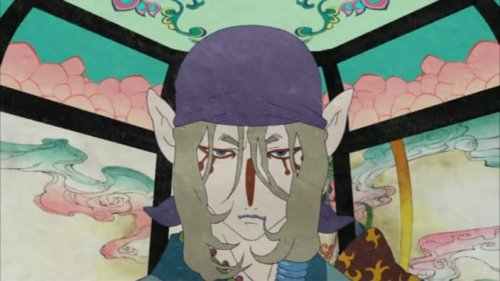
After much dragging of my heels on the last arc, I’ve finally finished Mononoke.
So, as I’ve not finished Dennou Coil yet, let’s call this the second best anime series of 2007.
It’s a 12 episode series, spinning off from the Bakeneko arc of 2006’s Ayakashi. I’ve not seen that arc yet, when I watched the first episode I hadn’t realised it was an anthology series of 3 unrelated stories and didn’t like the slow pace of Tetsuo Imazawa’s first episode. Luckily viewing of the Bakeneko arc isn’t essential, while there’s a literal callback in one arc and a thematic callback in another, you can follow it without viewing the previous series.
The series deals with five different supernatural creatures encountered by the mysterious Medicine Seller. They are unnatural spirits that have merged with strong emotions, to form a dangerous creature, a mononoke. The Medicine Seller travels the world hunting down and killing these creatures with his sword. However he cannot use his sword until he learns the Form, Truth and Regret of the individual mononoke. This places it in the realm of the occult detective genre, rather than a simple ghost story or folklore tale.
Director Kenji Nakamura brings a unique look to the animation. Colours are vibrant, but gloriously flat. Scenery is highly detailed, but facial designs are simple and expressive. Everything has had a texture applied giving the show the look of rough paper/parchment. There’s an obvious callback to Edo period woodcuts in it’s look (indeed 3/4 of the series is set in that period), but also to art movements inspired by those woodcuts. My art history is extremely ropey, so I’m sure this is something someone else could write far more about. Also there’s little anachronisms in there that are fascinating, the whole thing glorifies in it’s artifice, partly because there’s the sense of what we are seeing as the viewer is also an illusion in the eyes of the characters.
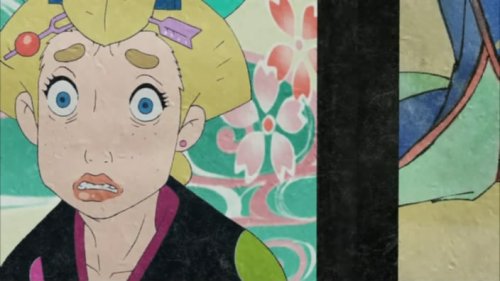
This arc deals with a pregnant woman visiting an inn who is haunted by child-like spirits. This is arguably the spookiest arc, though the final arc comes close. The focus seems more on the ghost story than the detective work of the Medicine Seller here. The anachronisms here are character designs of the inn staff and the pregnant woman, who are all drawn with a notably non-Japanese look. The ending of the arc sets the tone for most of the following arcs in being rather ambiguous.
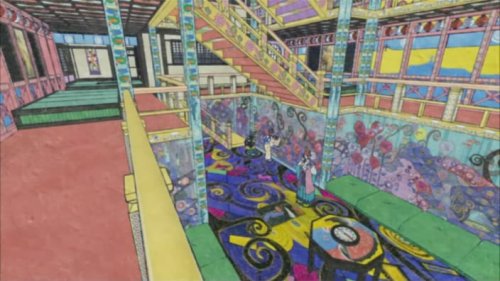
This is a longer arc (three episodes), that brings back Kayo from the Bakeneko arc. It has a much larger cast, more humour and plays more like detective story mixed with a dreamlike fantasy. It also has some mind blowing design work in the boat, Solarismaru. It deals with the aforementioned boat sailing into a cursed sea and dealing with sea monsters that lurk there. The name Solarismaru is reference to the science fiction novel by Stanislaw Lem, which involved the characters confronting their repressed memories and thoughts. The characters on board the Solarismaru are forced into a similar situation in the cursed seas. Again, there is an ambiguous ending, this time more to do with a subplot. This arc was where I noticed that there are clues/foreshadowing put in the scenery to the Truth, Form and Regret the Medicine Seller seeks. This is an attention to detail that blew my mind.
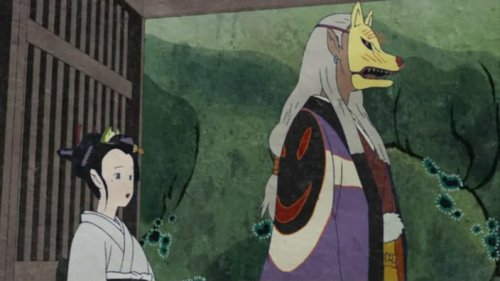
Back again to a two part arc, this deals with a woman facing execution for murdering her family, who is haunted by The Man In The Fox Mask. The Man in the Fox Mask steals the Medicine Seller’s face, and marries the woman to allow her to escape execution. Probably the most ambiguous of episodes, befitting of an arc that deals with masks and how the person you are expected to be and the person you want to be can be two different things.
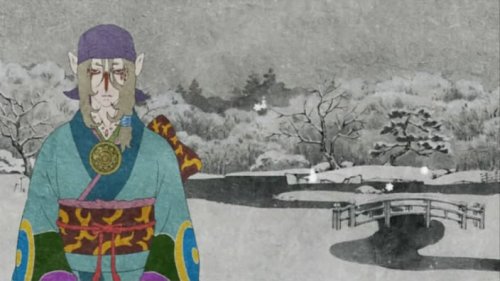
This deals with a competition between four gentlemen seeking the hand of a woman. The competition takes the form a smelling competition. Which is fascinating, it’s the first time I’ve ever encountered Genjikou, I know it’s real, but I can’t find decent English language description of it. Let’s just say it involves, incense, maths and Genji Monogatari. The episode gives you a decent description, though it flies by pretty fast. This is both the most straight forward story in terms of making sense of everything that happens in it, and also the one that feels most like ghost story. The editing in this episode is outstanding, there’s a sense in this arc and Noppera-bo of a little bit of belt tightening, but the direction and editing really make up for it.
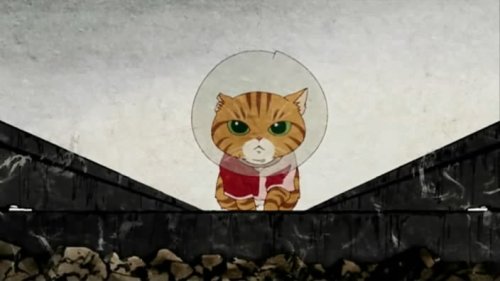
And the final arc, another 3 parter, is called Bakeneko. This time though the Medicine Seller encounters a Bakeneko in 1927. The colours are more subdued now (indeed there’s a sense of the colours getting more subdued throughout the series), and there’s a great sense of modernity creeping into Japan and rubbing against things that are older. Particularly as the Medicine Seller’s appearance has not changed at all. This is a great occult detective story, with the detective elements really brought to the fore. There’s some great visual metaphor going on here from the obvious use of shop mannequins representing bystanders, to elements of scenery designed to look like characters’ silhouettes.
I’ve tried not to go too deep into each story so as not spoil the revelations within each one, Iwa ni Hana did a sub-blog covering each episode in depth if you want some other, more intelligent, writing on the show.
This is a brilliant show and deserves your attention. I for one will be keeping an eye on Kenji Nakamura to see what he does next.